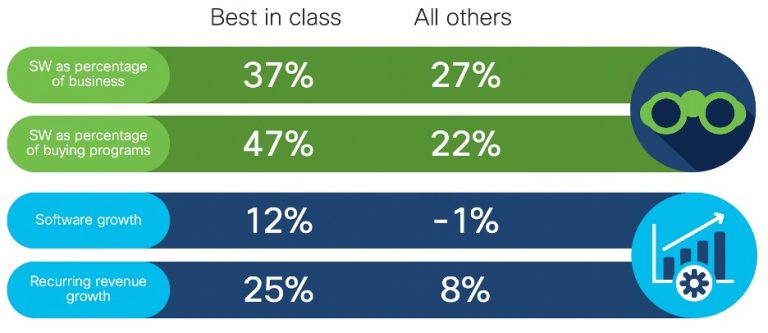Today, I’m excited to talk to you about how Cisco partners make more money, increase profits, and win with a focus on selling software. Of course, software has been a core part of our business and yours for quite some time. But today, we’re leveraging the power of the Cisco portfolio to offer transformative software licensing agreements and buying programs that will help you transform and become a best-in-class software-centric business.
Best-in-class partners drive growth in recurring revenue

Partners ask me all the time, “Gary, what does it mean to be best in class? Tell me what my peers are doing.”
Well, here’s some persuasive data: On average, partners are including software in their mix of total Cisco business about 27percent of the time. Not bad.
But our best-in-class partners are focused on driving software sales as lead motions in their go to market. In fact, they’re driving buying programs nearly half of the time when they engage a customer. And they’re experiencing 12 percent software growth year over year. They’re also experiencing 25 percent growth in software-based recurring revenue in a very challenging market, while many other partners have experienced flat-to-down revenue.
So, partners that are aggressively selling software are experiencing best-in-class results and pulling ahead of the pack.
What does it take to be best-in-class?
We’ve been on this transformational software selling journey together for a number of years. We started with those discrete software packages that you likely remember. And over the last few years, we’ve been bringing them together into a portfolio of software buying programs, including:
- Enterprise Agreement: allows all customers to make an enterprise-wide purchase commitment to Cisco software architecture(s)—a mainstay agreement
- Service Provider Agreement (SPNA): enables large service providers to commit to Cisco service provider software technology(s)
- Managed Service License Agreement (MSLA): makes it possible for partners delivering managed services to scale license capacity based on consumption
Our best-in-class partners are monetizing these agreements, taking them to market, and experiencing great success with their customers. In fact, they’re investing in and transforming their practices, driving software and buying programs as a lead motion in their go to market. They’re driving buying programs nearly half of the time they engage a customer, compared to about a quarter of the time for other partners.
Adding cross-architecture
But this success has just begun, because now we’re harnessing the power of multi-architecture. We’re bringing together our entire portfolio—combined with your value-added services—to create unprecedented levels of value for our customers.
Take the Enterprise Agreement, our lead buying program, for example. Customers love this agreement because it’s easy to buy, easy to consume, and easy to manage. We’ve now enhanced it by adding cross-architecture enrollments, adding more value to the agreement.
We have added the data center networking component to the Cisco DNA center enrollment as well. This enables partners to approach customers with an end-to-end networking enrollment that includes all campus and data center networking in one enrollment.
Another example: we’ve added Cisco security products such as Duo to a security choice enrollment, making it very easy to add security to another enrollment for a cross-architecture Enterprise Agreement.
Good for customers and Partners
Looking at the bigger picture, buying programs offer tremendous value for both customers and partners.
When customers buy Enterprise Agreements, they are making a commitment to Cisco and the Cisco partners who sold them. And in conjunction with this commitment, we’re offering a set of value levers that customers don’t get when they buy transactionally. These value levers include:
- Financial: includes true forward and not-to-exceed pricing.
- Operational: offers everything in one contract and one workspace with one renewal date—versus buying transactionally, which can result in multiple contracts to manage.
- Accelerated customer innovation: offers appliances and building in ramps, for example.
Increasingly, the Cisco CX value proposition and lifecycle story is leaning in to accelerate our customers’ value realization journeys toward the outcomes they care about.
Software buying programs are also good for partners.
- Enterprise Agreement deal sizes are bigger—on average 2X larger than à la carte buying. And when these agreements are cross-architectural, average deal sizes are 4X larger than à la carte buying.
- Larger deals post-Enterprise Agreement purchases: In the 12 months following an Enterprise Agreement deal, customers are buying 35% more across hardware, software, and services with Cisco and partners, than what they were spending annually before.
- One in six customers buy a second Enterprise Agreement within twelve months.
This data reinforces that, with buying programs, we’re capitalizing on the promise of delivering recurring revenue growth, cross-architecture expansion, and lifecycle value in a way that’s meaningful for our customers, our partners, and Cisco.
Are you ready to transform and increase your revenue?
CONNECT WITH US